Flows Around a Circular Cylinder Controlled by Electromagnetic Force at Subcritical Reynolds Numbers
YIN Ji-fu,YOU Yun-xiang,LI Wei,HU Tian-qun
(State Key Laboratory of Ocean Engineering,Shanghai Jiao Tong University,Shanghai 200240,China)
Flows Around a Circular Cylinder Controlled by Electromagnetic Force at Subcritical Reynolds Numbers
YIN Ji-fu,YOU Yun-xiang,LI Wei,HU Tian-qun
(State Key Laboratory of Ocean Engineering,Shanghai Jiao Tong University,Shanghai 200240,China)
This paper numerically researches the flow structures around a circular cylinder and the lift/drag characteristics influenced by the electromagnetic force in a weakly conductive fluid at subcritical Reynolds numbers with the method of Detached Eddy Simulation(DES).The results show that the electromagnetic force can increase the kinetic energy near the boundary layer of the circular cylinder,delay the flow separation near the cylinder wall,weaken the intensity of the streamwise and spanwise vortexes and decrease the drag force and the fluctuation amplitudes of the lift.Moreover,as the electromagnetic force parameter N exceeds a certain critical value,at which the separation point disappears,the flow behind the circular cylinder behaves like a jet,which generates a net thrust effect and implies the existence of negative drag phenomenon,while the fluctuation amplitudes of the lift are significantly reduced and close to zero.
subcritical Reynolds numbers;flow around a cylinder;electromagnetic force; flow control;Detached Eddy Simulation(DES)
0 Introduction
Cylindrical structures,such as marine platform risers and oil pipelines,are widely used in offshore engineering.Ocean currents flowing through these cylindrical structures will lead to separated flows and vortex shedding,which will in turn lead to periodic forces acting on structures that may result in horizontal and vertical vibrations.The vortex-induced vibrations may cause fatigue damage and rupture accidents of the cylindrical structures.Due to the de structive effect of the vortex-induced vibration on the offshore structures,separated flow control around cylindrical structures is of great importance in offshore engineering[1].
There have been lots of flow control methods and the related general overview can be found in Refs.[2-3].Traditionally,separation control methods have been classified as active and passive ones,depending on whether control involves energy expenditure or not.The passivecontrol techniques,including shaping,splitter plates and changing the surface,etc.,are used to control vortex shedding downstream of the cylinder[4].The primary advantage of the passive control approaches is their simplicity.In contrast to passive means,active flow control can be performed by blowing,suction,acoustic actuation,synthetic jet and in some cases by exerting electromagnetic forces[5-6].The electromagnetic force acts as a momentum source for the near wall flow and the main advantages of this strategy is that it can put energy into flow directly, has no mechanically moving parts and also acts only in specific regions[7-8].
The first stage of studying the electromagnetic control of electrolyte flows could date back to the 1960’s.The experimental researches gave an evidence of successful reduction for drag and the boundary layer thickness of the plate flow[9].But this approach did not attract much attention at that time.A renewed interest in electromagnetic flow control arose in the 1990’s.The majority of publications concentrated on the topics of turbulent drag reduction and flow separation of plate boundary layer[10-11].And on this basis,further experimental researches turned to control the flow around a cylinder covered with electrodes as well as permanent magnets generating a wall parallel force in the streamwise direction[12].The results of the flow control around a cylinder showed that the electromagnetic force can delay the flow separation and change the flow structure,as well as reduce the drag acting on a circular cylinder at low Reynolds number[13-16].Compared to the low Reynolds number flow,the flow influenced by electromagnetic force around a cylinder at high Reynolds number has obvious three-dimensional characteristics and received less attention[17-19].However,the mechanism of the flow around a circular cylinder controlled by electromagnetic force at high Reynolds number is still unclear, while it may be of great practical significance in offshore engineering where the Reynolds numbers are generally at least 103.
The experimental researches play an important role in investigating the active control, but they are always limited by the environment conditions for the high Reynolds number problems.In contrast to experimental means,the numerical simulation has become common and reliable in solving this problem with the development of the computer technology and Computational Fluid Dynamics(CFD)theory.Several well-known CFD simulation approaches have been used including the DNS(Direct Numerical Simulation),LES(Large Eddy Simulation), RANS(Reynolds Averaged Navier-Stokes),and DES(Detached Eddy Simulation)[20-24].The DNS is a simulation in computational fluid dynamics,in which the Navier-Stokes equations are numerically solved without any turbulence model and are only used to solve low Reynolds number flow problems because this method need huge amounts of computing.The LES operates on the Navier-Stokes equations by low-pass filtering to reduce the range of length scales of the solution and the computational cost.Nevertheless,it is not widely used to solve practical problem for the same reason as DNS.The RANS method using time-averaged solutions to the Navier-Stokes equations is unsatisfactory for high Reynolds numbers either,as the flow field around a circular cylinder is a typical flow phenomenon with boundary layer and a wide range of flow separation.
The DES is a modification of the RANS model,in which the model switches to a sub-grid scale formulation in regions fine enough for LES calculations.In the regions near solid boundaries,the turbulence length scale is smaller than the maximum grid dimension assigned for the RANS mode of solution.As the turbulence length scale is larger than the grid dimension,the regions are solved using the LES mode.Therefore the grid resolution is not as demanding as pure LES,thereby considerably cutting down the cost of the computation[20-21].The DES provides a single smooth velocity field across the RANS and the LES regions of the solution which can be the best option for this study.
The objective of the present work is to numerically research the mechanism of flow structures around a circular cylinder and the drag/lift characteristics controlled by electromagnetic force using the DES method with the SST κ-ω turbulence model at Re=3.9×103and Re=5.0×104.The electromagnetic force around a cylinder covered by electromagnetic actuators is added to the momentum equation which is obtained by solving the Maxwell equations using a finite element method.The methods of numerical simulation are described in Chapter 1.The CFD simulation results are presented in Chapter 2.In particular,the flow structure around a circular cylinder,lift/drag characteristics,vortex shedding frequency and the average flow separation angle without the control by electromagnetic force are outlined,and the variation characteristics of these parameters with non-dimensional electromagnetic interaction parameters are quantitatively analyzed.Additionally,the situations for these parameters at different Reynolds numbers are compared.This paper ends with the conclusions in Chapter 3.
1 Numerical simulation method
1.1 Governing equations
In the weakly conductive fluid,the cylinder is covered with a special array of electrodes and permanent magnets on the surface as shown in Fig.1.In this way,when the weakly conductive fluid flows around the cylinder,the Lorentz force around the surface of this cylinder is directed tangential to the cylinder surface.The Lorentz force is distributed around the entire surface of the cylinder and keeps the same direction on both half sides of the cylinder surface.
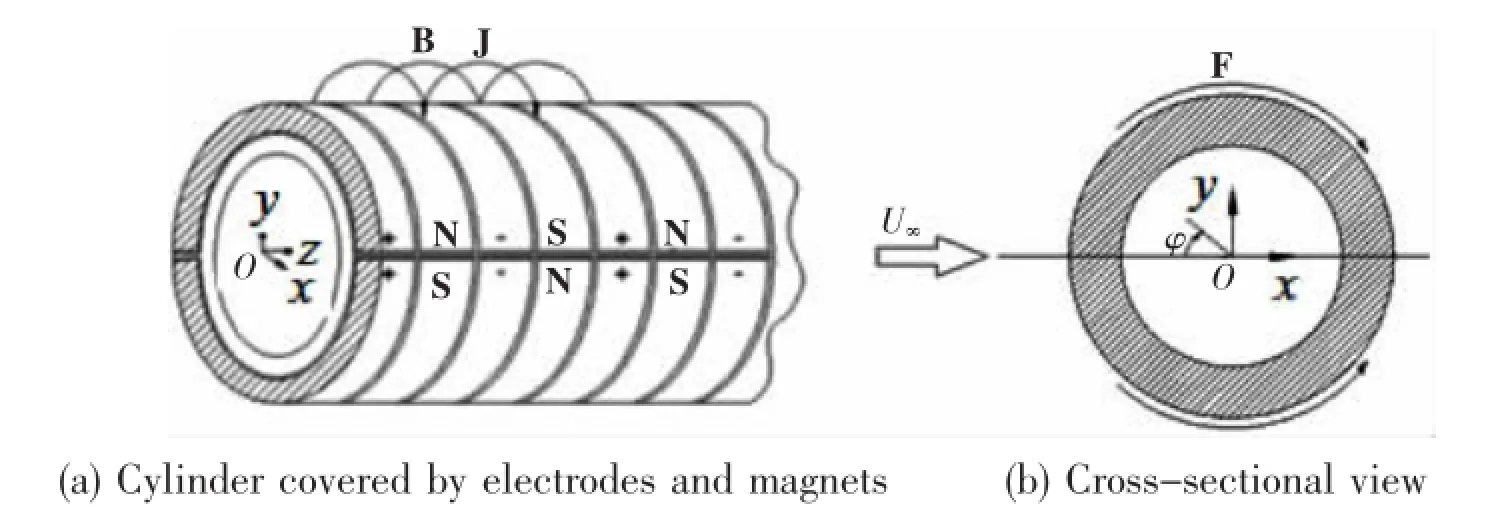
Fig.1 The model and coordinate system of the cylinder covered electromagnetic actuators
The governing equations describing the incompressible flow with the electromagnetic force Fiare given by

where t is time,p is the pressure,ρ is the density,ν is the dynamic viscosity of the fluid,ui(i=1,2,3)are the instantaneous velocity components,and xiand xjare the spatial vectors, respectively.As can be seen from Eq.(1),the electromagnetic forces act as a momentum source for the flow.
The electromagnetic force itself is the vector product of the current density J and the magnetic induction B:

The current density vector is given by Ohm’s law:

where E denotes the electric field,u the velocity and σ the electrical conductivity.This paper focuses on the electromagnetic force effects in weakly conductive fluids like seawater or electrolytes.In that case,the electrical currents originating from σu×B are usually much too low to produce any noticeable effect on the flow even for magnetic fields of several Tesla.The Lorentz force is thus changed into

The DES method is often based on various turbulence models,such as the one-equation Spalart-Allmaras model,realizable k-ε model and SST k-ω model.Among them,the SST k-ω turbulence model is a two-equation eddy-viscosity model,which gives good behavior in adverse pressure gradients and separating flow by the inclusion of transport effects into the formulation of the eddy-viscosity.To obtain the DES-SST k-ω formulation,the turbulent length scale lk-ωin the dissipation term of k equation is defined as

in which the model constant βkhas a value of 0.09.
In the DES method,the RANS and LES grid scale lDESis modified by

where CDESis the calibration constant,and△is the maximum local grid spacing.If the subscale stress model was prematurely initiated,it would result in the sharp decline of the Reynolds stress in the boundary layer which leads to the grid-induced separation phenomenon,so CDEShas a value of 0.61.In the cases that lk-ω≤CDES△,lDES=lk-ω,the model will operate in the SST mode in the boundary layer.In the other case of lk-ω>CDES△and lDES=CDES△,the model will operate in the LES mode and develop a flow instability past the step with the correct balance of the stresses.


Fig.2 Numerical results for the distributions of the electromagnetic force around the circular cylinder surface
1.2 Computational domain and boundary conditions
Fig.3 shows the schematic of the computational domain.The origin of the coordinate system is located at cylindrical centerline.x,y,()zdenote the coordinates along the streamwise, transverse and spanwise directions,respectively.The computational domain in the x and y directions are set at 60D and 30D.The upstream boundary is set at 15D away from the origin. The computational domain in the z direction is set to 10D.As is shown in Fig.3,a uniform velocity profile is adopted to the velocity inlet boundary and the surface along the spanwise direction while the outlet boundary condition is set to a pressure outlet.A symmetric boundary condition is employed to lateral surface and no slip wall to the cylinder surface.
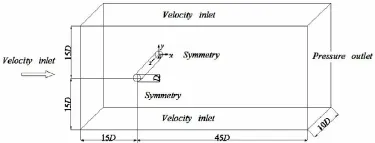
Fig.3 Schematic of computational domain
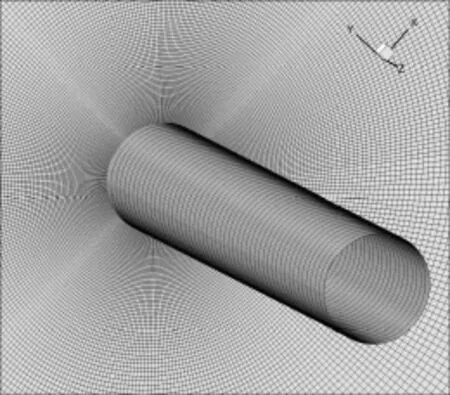
Fig.4 The grid for the computational domain
The computational domain is divided into H and O structural grids as shown in Fig.4. The grid is non-uniform in the x-y plane but uniform in the z direction.The distance from thecylinder surface to the nearest grid points△y is computed by the formula y+=0.172△yRe0.9/D in order to fix y*close to 1,where Re=u∞D/ν is the Reynolds number.In the present simulation,the Finite Volume Method(FVM)is employed to calculate the 3-D unsteady incompressible Navier-Stokers equation.A central differencing scheme is used for momentum discretization and a second order implicit scheme is employed to advance the equations in time.The well-known semi-implicit pressure linked equation algorithm is used to deal with the pressure-velocity coupling between the momentum and continuity equations.
2 Results and discussion
The electromagnetic interaction parameter and lift/drag coefficients used in the following are defined as

where u∞is the velocity,B0the main magnetic field intensity,E0the main electric field intensity,and j0=σE0.The interaction parameter N is the ratio of the Lorentz force to the inertial force in the fluid flow.Fland Fddenote the total lift and drag forces,respectively.S is the projected area of the cylinder perpendicular to the direction of the free-stream,S=D×H,where H is the spanwise length of the cylinder.
In the present investigation,the Reynolds numbers 3.9×103and 5.0×104belong to the subcritical flow regime.The DES method is utilized to simulate the flow around the circular cylinder without electromagnetic force.The grid number are 1.6×106and 2.1×106,respectively.The computational time steps are△t=0.05 s and△t=0.005 s at different Reynolds numbers. Firstly,use the DES model to simulate the flow characteristics in the absence of the Lorentz force.If the non-dimensional time is defined as t¯=tU/D,the flow around the circular cylinder which is unsteady at the beginning becomes absolutely stable at t¯=315.Turn on the electromagnetic force at this instant and the flow becomes stable again at t¯=375.
The boundary layer separation of the flow field around the cylinder is laminar.However, the wake flow field has significant three-dimensional characteristics and is absolutely turbulent at subcritical Reynolds numbers Re=3.9×103and Re=5.0×104.The vorticity distribution of the flow around cylinder at the non-dimensional time t¯=315 is shown in Fig.5.Results show that vortex shedding is clear as demonstrated by the developing vortices in the wake and a large-scale pulse along the spanwise direction of the cylinder at the two subcritical Reynolds numbers.In the process of the vortex moving downstream,the vortices experience obvious distortions.There are obvious three-dimensional flow characteristics in the flow and the phases, shapes and intensities of vortex shedding are different in the spanwise sections.The largescale vortex structure in the central region is enlarged and the small turbulent vortices in theperipheral region become more observable with the increase of the Reynolds number.In addition,the range of the vortex shedding in the vertical and downstream directions is also increased.
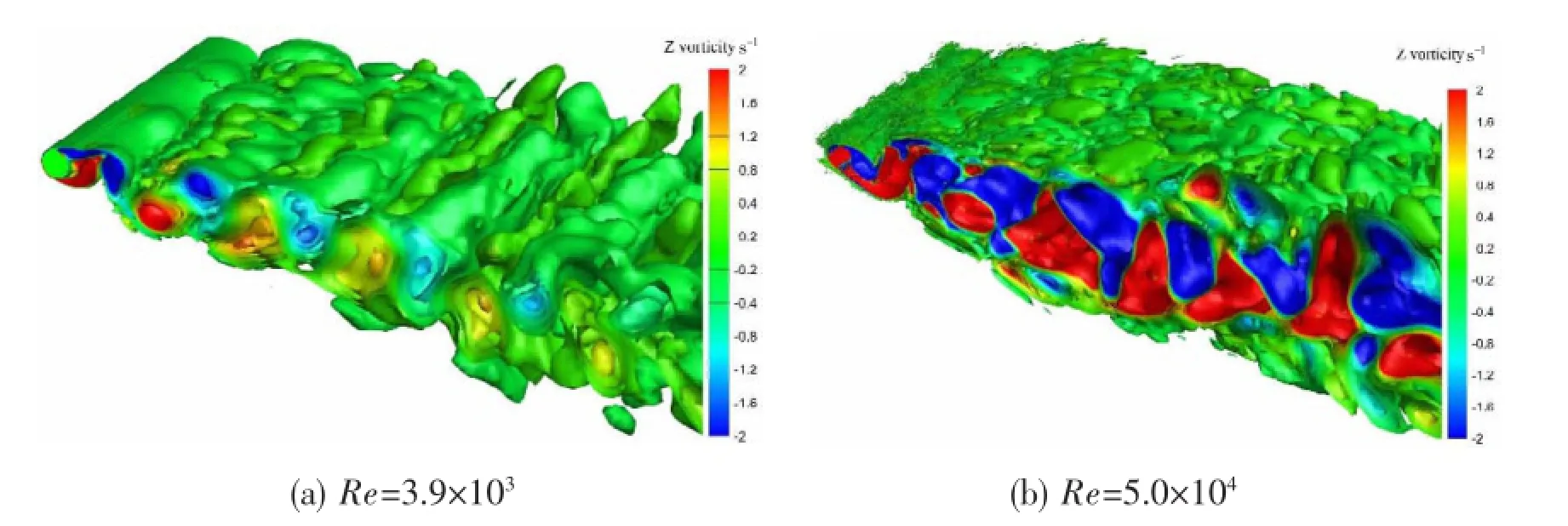
Fig.5 Numerical results for the vorticity distribution in the flow around a circular cylinder at t=315
Fig.6 shows the numerical results for total drag/lift coefficients of the circular cylinder at the two Reynolds numbers.The results show that the variation of drag/lift coefficients has quasi-periodic characteristics in spite of some random fluctuation,which implies that the vortex shedding is quasi-periodic but with fluctuations.Moreover,the fluctuation amplitude of the total drag/lift coefficients increases with the increasing Reynolds number.
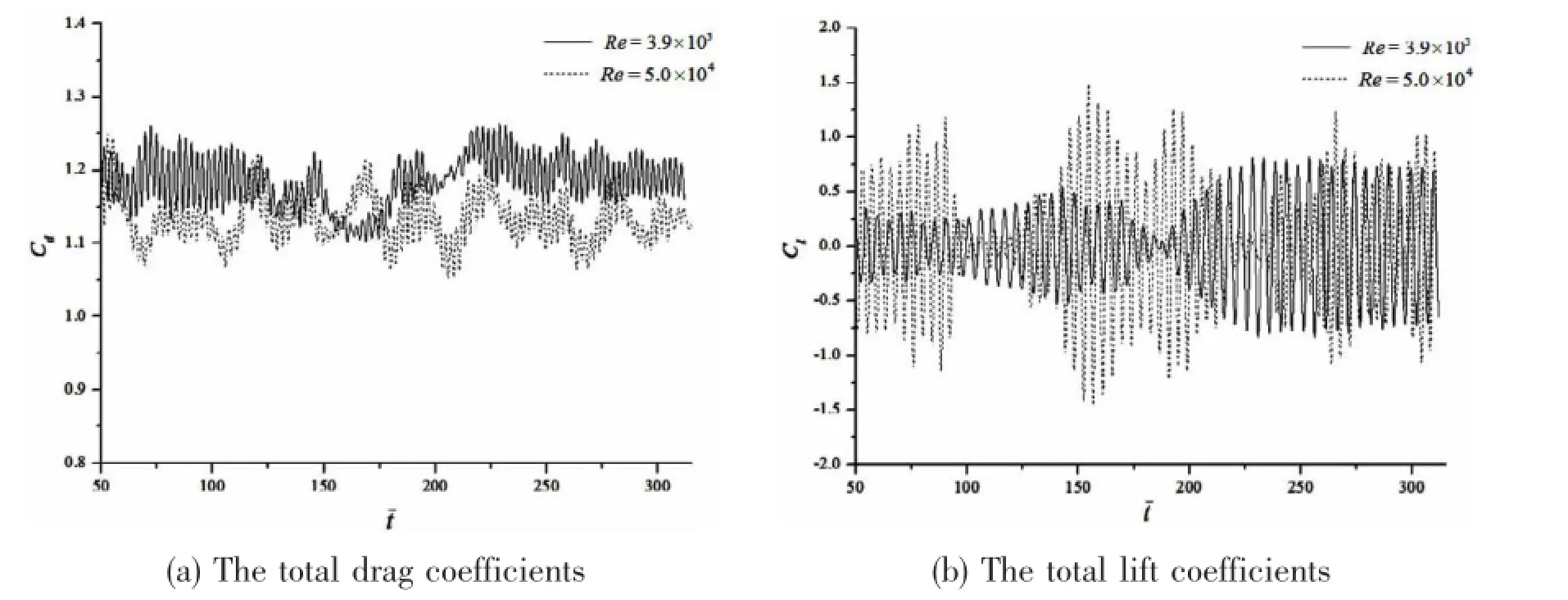
Fig.6 Numerical results for total drag/lift coefficients

Tab.1 Comparisons of the present results with the reference ones

2.1 Control of the flow structure
Fig.7 illustrates the numerical results for the effect of the electromagnetic force on the vorticity distribution of the flow around the circular cylinder at t¯=375.Obviously,the vorticity distribution characteristics in the near-wall region are changed and the vorticity fluctuations along the spanwise direction are weakened with the increasing electromagnetic force parameter.Once the interaction parameter reaches a certain critical value,the jet flow phenomenon behind the circular cylinder happens.
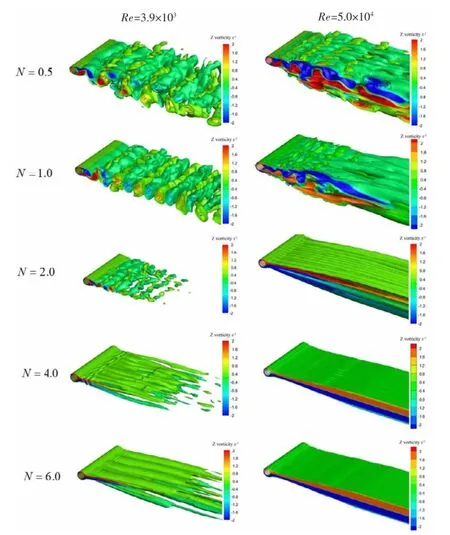
Fig.7 Numerical results for the effect of the electromagnetic force on the vorticity distribution of the flow around a circular cylinder at
The effect of the electromagnetic force on the vorticity distribution of the flow around a circular cylinder is not obvious at the interaction parameter value of N=0.5 for Re=3.9×103,while in the case where Re=5.0×104,the large scale eddies are induced in the central vortex area and their vertical ranges are smaller than those with no electromagnetic force,and the small scale eddies in the peripheral region shrink remarkably.When N=1.0,the large scale fluctuations along the spanwise direction of the cylinder are weakened and the vortex shedding becomes periodic at Re=3.9×103.In the case of Re=5.0×104,the large scale eddies appear in the central vortex area and their vertical range is further smaller while the small scale eddies in the peripheral region are weaker,and the large scale fluctuation is inhibited.When N= 2.0,the flow separation of the cylinder is inhibited and the vortex changes to be smaller ones and no periodic vortex shedding is detected in the wake at Re=3.9×103while for Re=5.0×104the flow separation is also inhibited with no large scale eddies and a jet flow is excited.When N=4.0 and N=6.0,the fluids get more and more accelerated by the Lorentz force and the jet action is induced for Re=3.9×103,while for Re=5.0×104,the jet wake grows to a laminar-like pattern.

The tangential velocity amplitude near the circular cylinder wall represents the fluid kinetic energy of the fluid inside and outside of the boundary layer.Fig.9 shows the effect of electromagnetic force on the tangential velocity near the circular cylinder wall at t¯=375 at two subcritical Reynolds numbers.Set u as the tangential velocity with the normal vector n.The results in the Fig.9 show that the electromagnetic force increases the tangential velocity and the fluid kinetic energy of the fluid inside and outside the boundary layers.Through the results,a reasonable conclusion is reached that an increase of the tangential velocity gradient near the wall helps to maintain the favorable pressure gradient along the circumference of the cylinder while varied regularities can be found with two different subcritical Reynolds numbers.
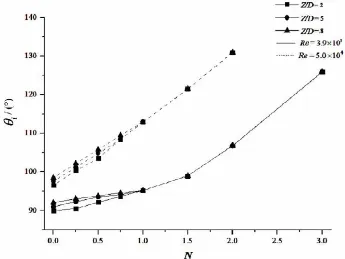
Fig.8 Variation of the separation angles with the electromagnetic interaction parameters at different spanwise cross-sections
In the absence of the electromagnetic force,the variation characteristics,and the position and maximum value of the tangential velocity are not the same.There are obvious three-di-mensional characteristic in the flow.When N=0.5,no obvious effect of electromagnetic force on the tangential velocity is found for Re=3.9×103,while for Re=5.0×104,such effect apparently influences the flow,though the maximum value and the position of the velocity have the same trend of variation.When N=1.0,the maximum value and the position of the maximum of the tangential velocity are the same for two subcritical Reynolds numbers and the maximum value of the tangential velocity is obvious increased for Re=5.0×104.

Fig.9 Effect of the electromagnetic force on the tangential velocity near the circular cylinder wall at t=375(a),(b),(c)are for Re=3.9×103and(d),(e),(f)for Re=5.0×104
2.2 Control of the drag/lift characteristics
Fig.10 shows the effect of the electromagnetic force on the temporal evolution of the total drag coefficient for the circular cylinder,which implies that the electromagnetic force can significantly reduce the mean and impulse values of the total drag coefficient at the two different Reynolds numbers.When N=6,the average drag coefficient is reduced more than 70%at Re= 3.9×103.For Re=5.0×104,at the value of N=2,the average drag coefficient decreases about100%,while in the case of N>2,the total drag becomes negative,leading to the net thrust phenomena.
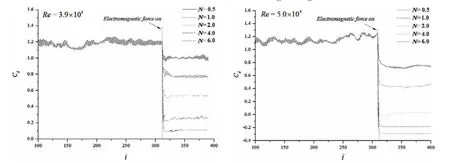
Fig.10 Effect of electromagnetic force on temporal evolution of total drag coefficient
The variation characteristics for the total average drag coefficient of the circular cylinder with the electromagnetic force interaction parameters for the two different subcritical Reynolds numbers are shown in Fig.11.The total average drag coefficient decreases with increasing interaction parameter at different Reynolds numbers.For an equivalent value of electromagnetic force parameter,the reduction of the total average drag coefficient at Re= 5.0×104is higher than that at Re=3.9×103.The total average drag coefficient exponentially decreases with the increase of interaction parameter for both Reynolds numbers.The fitting equation is y=e0.1855-0.4409x+0.0097x2for Re=3.9×103and y=1.440 7e0.6928x-0.291 9 for Re=5.0×104.

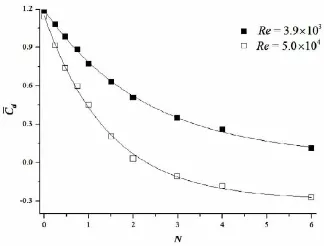
Fig.11 Variation of total average drag coefficient with electromagnetic force interaction parameters
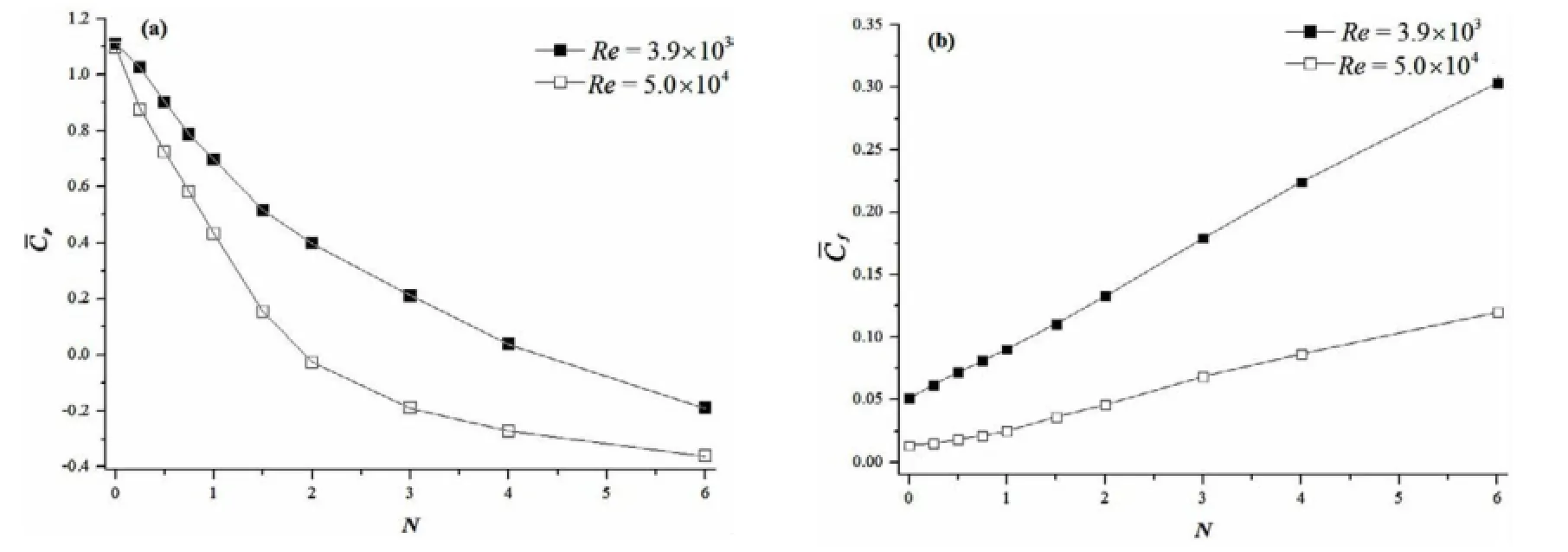
Fig.12 Variation of total average pressure and friction coefficients with electromagnetic force interaction parameters
The effect of the electromagnetic force on the temporal evolution of the total lift coefficient for the circular cylinder is illustrated in Fig.13.The results imply that the electromagnetic force can significantly decrease the lift fluctuations amplitudes of the circular cylinder. When the interaction parameter N reaches a certain value,the fluctuations amplitudes are close to zero.When N=0.5,the reduction of lift fluctuations amplitudes is not obvious because the electromagnetic force has little effect to the vortexes for Re=3.9×103,while for Re=5.0×104, the lift is seriously decreased.When N=1.0,the value of lift falls rapidly and exhibits periodic variation at Re=3.9×103while the lift has little fluctuations and is close to zero at Re=5.0× 104.At N=2.0,the lift fluctuations amplitudes are greatly reduced and the vortexes become small ones at Re=3.9×103,and a slight fluctuation and the jet flow phenomenon can be detected at Re=5.0×104.
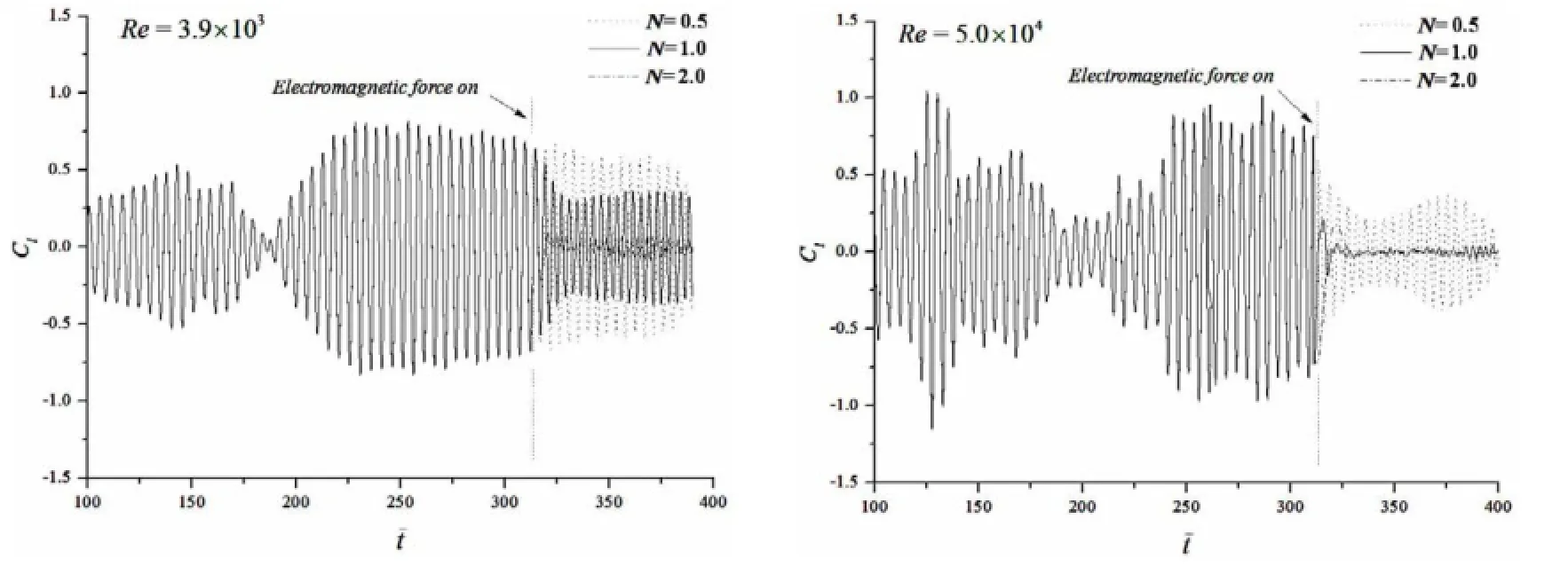
Fig.13 Effect of the electromagnetic force on temporal evolution of total lift coefficient
Fig.14 shows the variation characteristics for the root mean square value of the total lift coefficient Clrmsof the circular cylinder with the electromagnetic force interaction parameters.The results show that the electromagnetic force can significantly decrease the Clrms.When N reaches a certain value,the value of Clrmsis close to zero.At Re=3.9×103,as N≤1.0,Clrmsdecreases linearly and at value of N>1.0,Clrmsis greatly decreased and close to zero.At Re=5.0×104, such value of N is estimated to 0.75.
3 Conclusions
The flow structures around a circular cylinder and the drag/lift characteristic controlled by electromagnetic force have been simulated by using the DES method with the SST k-ω turbulence model at Re=3.9×103and Re=5.0×104.The CFD simulation results show that thevariation characteristics of flow structures and drag/lift around a circular cylinder change with the non-dimensional electromagnetic interaction parameter.
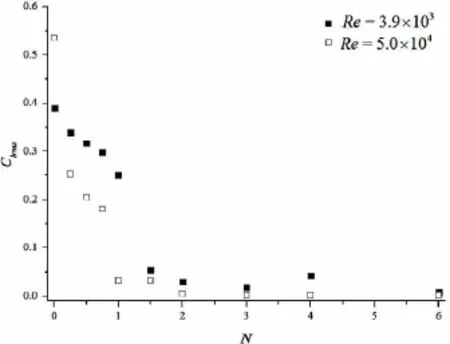
Fig.14 Variation of root mean square value of total lift coefficient with electromagnetic force interaction parameters
There is a critical electromagnetic interaction parameter value Nc1,and when N The total average pressure coefficient decreases and the friction coefficient increases with increasing interaction parameter N.At higher Reynolds numbers,the reduction of total average pressure coefficient is larger and the raise of friction coefficient is smaller than that at lower Reynolds number.When the jet flow phenomenon occurs,the drag of a circular cylinder becomes negative and the net thrust force is generated.There is also a critical value Nc3which decreases with increasing Reynolds number.When N [1]Williamson C H K.Vortex dynamics in the cylinder wake[J].Annual Review of Fluid Mechanics,1996,28(1):477-539. [2]Zdravkovich M M.Review and classification of various aerodynamic and hydrodynamic means for suppressing vortex shedding[J].Journal of Wind Engineering and Industrial Aerodynamics,1981,7(2):145-189. [3]Gad-el Hak M.Flow control:Passive,active,and reactive flow managements[M].Cambridge:Cambridge University Press, 2000. [4]Kwon K,Choi H.Control of laminar vortex shedding behind a circular cylinder using splitter plates[J].Physics of Fluids, 1996,8(2):479. [5]Li Z,Navon I M,Hussaini M Y,et al.Optimal control of cylinder wakes via suction and blowing[J].Computers&Fluids, 2003,32(2):149-171. [6]Atktin C J,Mughal M S.Parametric studies on the application of distributed roughness elements for laminar flow control [C]//35th AIAA Fluid Dynamics Conference Exhibit,6-9 June,2005.Toronto,Ontario Canada,2005. [7]Rudibert K.Active flow control[J].In“Notes on Numerical Fluid Mechanics and Multidisciplinary Design”.Berlin,Germany,2006(95):8-10. [8]Chen Hong.Active control for separation flow by electromagnetic force[D].Wuhan:Ph.D.thesis,Huazhong University of Science and Technology,2011.(in Chinese) [9]Gailitis A,Lielausis O.On a possibility to reduce the hydrodynamic resistance of a plate in an electrolyte[J].Applied Magnetohydrodynamics,Rep.Phys.Inst.,1961,12:143-146.(in Russian) [10]Henoch C,Stace J.Experimental investigation of a salt water turbulent boundary layer modified by an applied streamwise magnetohydrodynamic body force[J].Physics of Fluids,1995,7(6):1371-1383. [11]Mei Dongjie,Fan Baochun,Chen Yaohui,et al.Experimental investigation on turbulent channel flow utilizing spanwise oscillating Lorentz force[J].Acta Physica Sinica,2010,59(12):8335-8342.(in Chinese) [12]Weier T,Gerbeth G,Mutschke G,et al.Experiments on cylinder wake stabilization in an electrolyte solution by means of electromagnetic forces localized on the cylinder surface[J].Experimental Thermal and Fluid Science,1998,16(1-2):84-91. [13]Oliver P,Roger G.Electromagnetic control of sea-water flow around circular cylinder[J].European Journal of Mechanics-B/Fluids,2001,20(2):255-274. [14]Zhou Benmou,Fan Baochun,Chen Zhihua,et al.Experiments on vortex suppression and vortex acceleration by means of electromagnetic field localized on the cylinder surface[J].Journal of Experimental Mechanics,2004,19(2):242-247.(in Chinese) [15]Zhang Hui,Fan Baochun,Chen Zhihua.Cylinder wake flow affected by width of electromagnetic actuator[J].Engineering Mechanics,2007,24(12):164-168.(in Chinese) [16]Zhang Hui,Fan Baochun,Chen Zhihua,et al.Effect of the Lorentz force on cylinder drag reduction and its optimal location[J].Fluid Dynamics Research,2011,43(1):1-18. [17]Kim S J,Lee C M.Investigation of the flow around a circular cylinder under the influence of an electromagnetic force[J]. Experiments in Fluids,2000,28(3):252-260. [18]Kim S J,Lee C M.Control of flows around a circular cylinder:Suppression of oscillatory lift force[J].Fluid Dynamics Research,2001,29(1):47-63. [19]Yin Jifu,Li Wei,You Yunxian,et al.The DES simulation for flow control around a circular cylinder using the electromagnetic force at a subcritical Reynolds number[J].Chinese Journal of Hydrodynamics,2013,28(4):495-506.(in Chinese) [20]Travin A,Shur M,Strelets M,et al.Detached-eddy simulations past a circular cylinder[J].Flow,Turbulence and Combustion,2000,63(1-4):293-313. [21]Squires K D.Detached-eddy simulation:current status and perspectives[M].In“Direct and large-eddy simulation”,Verlag Springer,Netherlands,2004:465-480. [22]Elmiligui A,Abdol-Hamid K S,Massey S J,et al.Numerical study of flow past a circular cylinder using RANS,hybrid RANS/LES and PANS formulations[J].AIAA Paper,2004:49-59. [23]Benim A C,Pasqualotto E,Suh S H.Modelling turbulent flow past a circular cylinder by RANS,URANS,LES and DES [J].Progress in Computational Fluid Dynamics,2008,5(8):299-307. [24]Ong M C,Utnes T,Holmedal L E.Numerical simulation of flow around a smooth circular cylinder at very high Reynolds numbers[J].Marine Structures,2009,22(2):142-153. [25]Norberg C.Flow around a circular cylinder:Aspects of fluctuating lift[J].Journal of Fluids and Structures,2001,15(3):459-469. [26]Norberg C.Effects of Reynolds number and low-intensity free-stream turbulence on the flow around a circular cylinder [M].Publ.No.87/2.Department of Applied Thermoscience and Fluid Mechanics,Halmers University of Technology,Sweden,1987. 亚临界区雷诺数下电磁力控制圆柱绕流场特性研究 尹纪富,尤云祥,李巍,胡天群 采用脱体涡模拟方法对弱电解质中电磁力作用下圆柱绕流场及其升阻力特性进行了数值模拟与分析。研究结果表明,在亚临界区雷诺数下电磁力可以提高圆柱体边界层内的流体动能,延缓圆柱体近壁面流动分离,减弱绕流场中流向和展向大尺度涡的强度,减小圆柱体阻力及其升力脉动幅值;当电磁力作用参数大于某个临界值后,流动分离角消失,在圆柱体尾部产生射流现象,电磁力产生净推力作用,出现负阻力现象,而且升力脉动幅值显著减小且接近于零。 亚临界区雷诺数;圆柱绕流;电磁力;流动控制;DES数值模拟 O357.4 :A 尹纪富(1984-),男,上海交通大学博士研究生; 1007-7294(2015)12-1431-14 O357.4 :A 10.3969/j.issn.1007-7294.2015.12.001 尤云祥(1963-),男,上海交通大学教授,博士生导师; 李巍(1971-),男,上海交通大学副教授; 胡天群(1957-),男,上海交通大学研究员。 Received date:2015-06-21 Foundation item:Supported by the National Natural Science Foundation of China(Grant No.11272211); the Foundation of State Key Laboratory of Ocean Engineering,Shanghai Jiao Tong University(Grant No.GP010819) Biography:YIN Ji-fu(1984-),male,Ph.D.candidate of Shanghai Jiao Tong University;YOU Yun-xiang(1963-), male,professor/tutor,corresponding author,E-mail:youyx@sjtu.edu.cn.
(上海交通大学海洋工程国家重点实验室,上海200240)

